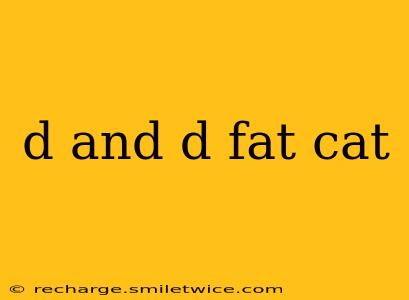The "Fat Cat" in Dungeons & Dragons isn't a specific creature or monster. Instead, it's a delightfully versatile archetype representing a wealthy, often corrupt, and usually self-satisfied individual. This guide will help Dungeon Masters (DMs) create compelling and memorable Fat Cat NPCs, exploring their motivations, potential storylines, and how they can enrich your campaign.
What Makes a D&D Fat Cat?
A D&D Fat Cat isn't just about being overweight; it's about embodying a specific lifestyle and personality. Key characteristics include:
- Wealth and Influence: Fat Cats possess significant financial resources and often wield considerable political or social power. This influence might be legitimate or gained through nefarious means.
- Self-Importance and Arrogance: They have an inflated sense of self-worth and often treat others with disdain, believing their wealth entitles them to special treatment.
- Complacency and Laziness: They often lead lives of luxury and ease, lacking the drive or ambition to actively pursue further gains. Their focus is usually on maintaining their current status quo.
- Potential for Corruption: Many Fat Cats have accumulated their wealth through questionable means, involving bribery, blackmail, or outright illegal activities.
How to Create a Memorable Fat Cat NPC
To create a truly memorable Fat Cat, consider these elements:
- Backstory: How did they acquire their wealth? Were they born into it, or did they claw their way to the top? What are their regrets, ambitions, and hidden vulnerabilities? A detailed backstory adds depth and complexity.
- Personality Quirks: Give them unique quirks that make them stand out. Do they have a peculiar habit, a favorite phrase, or a phobia? These details bring them to life.
- Motivations: What drives them? Are they motivated by greed, fear of losing their status, or a desire for legacy? Understanding their motivations helps predict their actions.
- Appearance: While the "fat" aspect is part of the stereotype, focus on details that highlight their wealth and status—expensive clothing, jewelry, and a generally well-maintained appearance despite their lifestyle.
What are some common Fat Cat archetypes in D&D?
Here are a few examples to inspire you:
- The Corrupt Official: A mayor, governor, or other high-ranking official who uses their position to enrich themselves and their cronies.
- The Greedy Merchant: A wealthy merchant prince who engages in unfair trade practices and exploits their workers.
- The Patron of the Arts (with a dark secret): A seemingly benevolent art collector who secretly funds illegal activities or possesses a morally questionable past.
How can I use a Fat Cat NPC in my campaign?
Fat Cats can play various roles in your campaign:
- Antagonists: Their greed and corruption can create conflict and drive the plot.
- Quest Givers: They might offer lucrative (though potentially morally ambiguous) quests.
- Obstacles: Their influence can create hurdles for the party to overcome.
- Allies (with strings attached): They might offer help, but expect something in return.
What are some potential storylines involving a Fat Cat?
- The Heist: The party must steal something valuable from the Fat Cat's heavily guarded mansion.
- The Investigation: The party must uncover the Fat Cat's illicit activities and bring them to justice.
- The Rescue: The Fat Cat's family or associates are kidnapped, and the party must rescue them.
What are some ways to make a Fat Cat more than a simple stereotype?
Avoid clichés by giving them unexpected depth and complexity. Perhaps they are secretly philanthropic, or they have a hidden vulnerability that makes them sympathetic. Make them multi-faceted individuals, not just one-dimensional villains. Consider adding layers such as unexpected talents or hidden skills.
By carefully crafting your Fat Cat NPC and integrating them into your campaign, you can add a layer of intrigue, humor, and challenge that will keep your players engaged and entertained. Remember, a well-developed Fat Cat is more than just a caricature; they are a powerful tool for storytelling in your D&D world.
